Tagalog used to be written with the Baybayin alphabet, which probably developed from the Kawi script of Java, Bali and Sumatra, which in turn descended from the Pallava script, one of the southern Indian scripts derived from Brahmi. Today the Baybayin alphabet is used mainly for decorative purposes and the Latin alphabet is used to write to Tagalog.
The name Tagalog derives from tagá-ílog, which means "resident beside the river". Little is known of the history of the language before the arrival of the Spanish in the Philippines during the 16th century as no eariler written materials have been found.
The earliest known book in Tagalog is the Doctrina Cristiana (Christian Doctrine) which was published in 1593. It was written in Spanish and Tagalog, with the Tagalog text in both Baybayin and the Latin alphabet.
Notable features
- Type of writing system: syllabic alphabet in which each consonant has an inherent vowel /a/. Other vowels are indicated either by separate letters, or by dots - a dot over a consonant changes the vowels to an /i/ or and /e/, while a dot under a consonant changes the vowel to /o/ or /u/.
- The inherent vowel is muted by adding a + sign beneath a consonant. This innovation was introduced by the Spanish.
- Direction of writing: left to right in horizontal lines.
The Baybayin alphabet

| A a | B b | K k | D d | E e | G g | H h | I i | L l | M m |
|---|---|---|---|---|---|---|---|---|---|
| a | ba | ka | da | e | ga | ha | i | la | ma |
| N n | Ng ng | O o | P p | R r | S s | T t | U u | W w | Y y |
| na | nga | o | pa | ra | sa | ta | u | wa | ya |
http://www.tagaloglang.com/abakada.htm
Pronunciation

Notes
- Between vowels k has a tendency to become [x], and g quite often becomes [ɰ].
- [i~e~ɛ] and [u~o~ɔ] were once allophones.
Sample text in the Baybayin alphabet

Sample text in the Latin alphabet
Ang lahat ng tao'y isinilang na malaya at pantay-pantay sa karangalan at mga karapatan. Sila'y pinagkalooban ng katwiran at budhi at dapat magpalagayan ang isa't isa sa diwa ng pagkakapatiran.A recording of this text
Translation
All human beings are born free and equal in dignity and rights. They are endowed with reason and conscience and should act towards one another in a spirit of brotherhood.(Article 1 of the Universal Declaration of Human Rights)
Information about Tagalog |
Tagalog phrases |
Numbers in Tagalog |
Tower of Babel in Tagalog |
Tagalog learning materials
Links
Information about the Tagalog languagehttp://en.wikipedia.org/wiki/Tagalog
http://www.towerofbabelfish.com/language-resources/learn-tagalog/
http://www.seasite.niu.edu/Tagalog/tagalog_mainpage.htm
Online Tagalog lessons
http://www.seasite.niu.edu/Tagalog/
http://www.tagalog1.com/Index_Lessons.jsp
http://www.tagaloglang.com
https://learningtagalog.com/grammar
https://www.glovico.org/en/tagalog
Online Tagalog dictionary
http://www.tagalog-dictionary.com
Tagalog Translators
http://www.tagalogtranslator.nl
http://home.planet.nl/~roosiedb/tagtrans3/tagtrans3.html
Tagalog Electronic talking dictionaries
http://www.ectaco.com
Information about Philippine history, language and scripts
http://www.mts.net/~pmorrow/
http://www.eaglescorner.com/baybayin/
http://www.paradisephilippines.ph/2007/12/24/alibata-filipinos-ancient-writing-script/
http://www.bibingka.com/dahon/









.jpg)

.jpg)
.jpg)





0 comments:
Post a Comment
Note: Only a member of this blog may post a comment.